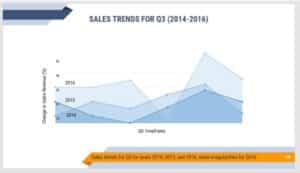So, you’ve tracked your departments/ project’s performance, you’ve coordinated efforts with your team, you’ve met your goals, and now what?
Now it’s time to present your work.
Sadly, so often good hard work is overshadowed by a badly put together presentation. To make sure you receive credit where credit is due, and that double thumbs up from the boss man, here are some basic tips for perfecting your presentations.
1.Take the time to prepare
You may have a million things to work on, and feel like you can get away with throwing a few PowerPoint slide together right before a meeting, and while this may work sometime, other times you might end up with a sloppy slide like this:
Now while you may be thinking “this looks like a four year-old made this slide, there is no way even my worst work would look that bad”, there are errors in this slide that are commonly made. This may be an extreme example but we can take away key concepts in terms of design and format:
- Use of color: try to keep it simple and use two colors (three maximum) on your slides. Anything less is boring and anything more is overwhelming for your viewers.
- Font: keep font uniform throughout slides. Have a set font and size for all your titles, and the same for your body paragraphs.
- Graphs: A graph is a great tool to support your argument if present correctly. Make sure your graphs have axis labels, a legend if necessary, a descriptive title, and colors that coordinate with the general theme of your presentation.
- Data: Alongside your graphs, make sure all data is labelled, and numbers have an explanation if needed.
- Format: Make sure no elements are overlapping, such as a graph covering a title or writing. This will help your slide look more professional and clean. Focus on simplicity and uniformity between slides.
Apply these tips and aim for something more like this:
2. Know your audience
It’s something we all learned in school while learning how to write a paper in school; know who you are speaking to. Are you presenting to your coworkers? Your boss? The Board of Directors? Each will require a different style, formality, and context for their presentation. Ask ahead of time who will be at the meeting you are presenting at, so you will know what points to include, what data to focus on, and what things might need explaining for outsiders who haven’t been as involved in the project. This will allow you to cater your presentation better to those you are presenting to, as well as make you feel better prepared.
3. Practice what you are going to say
Maybe it’s your first week on the job, or maybe you’ve been working here for 5 years, presenting can be stressful and often nerve wracking. In fact, studies have show that 73% of the U.S. population has a fear of public speaking. So in order to prevent you from nervously forgetting what you were going to say, make sure you have rehearsed your main points ahead of time. Practice, practice, practice, and relax knowing you’ve put in your work.
4. Get a fresh set of eyes
Sometimes our presentations become our “babies” and we aren’t willing to look for ways to improve. Asking a coworker to look over your presentation slides or notes, is a great way to get around this. Make sure you ask for honest feedback, and then apply what they tell you without taking offense. This will grow your trust in your coworkers as well give your presentation an extra review.
5. Reflect
Each presentation is an opportunity for learning and growth. After your presentation make sure you take time to reflect on how it went. What do you feel went well? What didn’t go quite as planned? Ask someone whom was present in the meeting to give you feedback as well. Take what you’ve learned from your presentation and decide how you will incorporate it into your next presentation, in order to make it even better.
Need anymore help on your presentation? KPI Fire’s dashboards are a great visual tool to showcase project and department achievements. Sign up here to start your free trial today:






